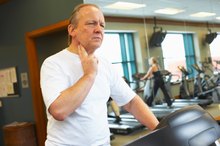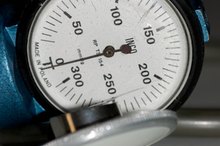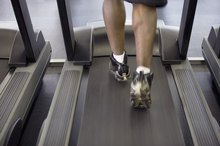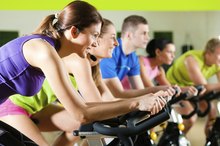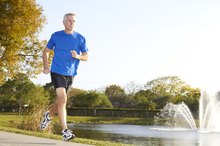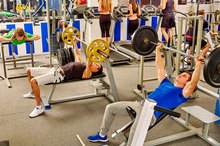What does fact checked mean?
At Healthfully, we strive to deliver objective content that is accurate and up-to-date. Our team periodically reviews articles in order to ensure content quality. The sources cited below consist of evidence from peer-reviewed journals, prominent medical organizations, academic associations, and government data.
The information contained on this site is for informational purposes only, and should not be used as a substitute for the advice of a professional health care provider. Please check with the appropriate physician regarding health questions and concerns. Although we strive to deliver accurate and up-to-date information, no guarantee to that effect is made.
How Do Vital Signs Change During Anaerobic Exercise?
Anaerobic exercise involves high-intensity activity that is short-lasting. In anaerobic exercise, such as weightlifting and sprinting, your body’s need for oxygen exceeds the oxygen that is available.
The term anaerobic means “without oxygen.” As with aerobic exercise, anaerobic exercise temporarily changes your vital signs, including heart rate, blood pressure, breathing rate and body temperature 12.
Heart Rate
For the average adult, a normal resting heart rate is 60 to 100 beats per minute. With each heartbeat, your heart sends blood throughout your body to deliver oxygen to your tissues.
During anaerobic exercise, your body’s need for oxygen increases. As a result, your heart rate increases in direct proportion to the intensity of the exercise 4. During anaerobic exercise, your heart rate will typically be above 85 percent of your maximum heart rate, which is approximately your age subtracted from 220.
- For the average adult, a normal resting heart rate is 60 to 100 beats per minute.
- During anaerobic exercise, your heart rate will typically be above 85 percent of your maximum heart rate, which is approximately your age subtracted from 220.
Blood Pressure
Why Does Your Heart Beat Fast When You Exercise?
Learn More
Blood pressure is the measurement of the blood’s force in your arteries 2. In general, normal blood pressure is defined as 120 over 80. The top, or systolic, number represents the pressure when the heart contracts. The bottom, or diastolic, number represents the pressure when the heart relaxes.
Your body responds to anaerobic exercise by increasing systolic blood pressure 2. When you lift weights, the muscle contraction causes a decrease in blood flow. To compensate, the heart beats faster in an effort to deliver more oxygen to your muscles. Systolic blood pressure increases in proportion to exercise intensity 2.
- Blood pressure is the measurement of the blood’s force in your arteries 2.
- The bottom, or diastolic, number represents the pressure when the heart relaxes.
Breathing Rate
Breathing is a complex physiological process that brings nutrients into your body. A normal resting breathing rate is between 12 to 18 breaths per minute.
During anaerobic exercise, your breathing rate increases along with your heart rate. Your sympathetic nerves signal your respiratory muscles to increase your breathing rate in an effort to bring more oxygen into the body and the blood. In addition to bringing oxygen in, the increase in breathing rate also expels waste products such as carbon dioxide.
- Breathing is a complex physiological process that brings nutrients into your body.
- During anaerobic exercise, your breathing rate increases along with your heart rate.
Temperature
Is Exercise the Cause of Hyperventilation?
Learn More
The average adult body temperature is 98.6 degrees Fahrenheit, although temperatures between 97.8 F to 99.1 F are considered normal. During anaerobic exercise, the energy used to power your muscles during the intense bursts of movement is lost as heat, increasing your body temperature.
That is why you sweat during exercise. Your body prevents your body temperature from getting too high by releasing the heat as sweat. As the sweat evaporates, it cools your body.
- The average adult body temperature is 98.6 degrees Fahrenheit, although temperatures between 97.8 F to 99.1 F are considered normal.
- During anaerobic exercise, the energy used to power your muscles during the intense bursts of movement is lost as heat, increasing your body temperature.
Related Articles
References
- Medline Plus: Vital Signs
- The University of New Mexico: Exercise and Resting Blood Pressure
- MedlinePlus: Pulse
- PT Direct: Vascular responses to exercise
- Patel H, Alkhawam H, Madanieh R, Shah N, Kosmas CE, Vittorio TJ. Aerobic anaerobic exercise training effects on the cardiovascular system. World J Cardiol. 2017;9(2):134-138. doi:10.4330/wjc.v9.i2.134
- Scott CB. Contribution of anaerobic energy expenditure to whole body thermogenesis. Nutr Metab (Lond). 2005;2(1):14. doi:10.1186/1743-7075-2-14
- Agrotou S, Karatzi K, Papamichael C, et al. Effects of chronic anaerobic training on markers of sub-clinical atherosclerosis. Hellenic J Cardiol. 2013;54(3):178-85.
- Mehanna E, Hamik A, Josephson RA. Cardiorespiratory Fitness and Atherosclerosis: Recent Data and Future Directions. Curr Atheroscler Rep. 2016;18(5):26. doi:10.1007/s11883-016-0580-7
- Manshouri M, Ghanbari-Niaki A, Kraemer R, et al. Time Course Alterations of Plasma Obestatin and Growth Hormone Levels in Response to Short-term Anaerobic Exercise Training in College Women. Appl Physiol Nutr Metab. 2008;33(6):1246-9. doi: 10.1139/H08-098.
- Salvadori A, Fanari P, Marzullo P, et al. Short Bouts of Anaerobic Exercise Increase Non-esterified Fatty Acids Release in Obesity. Eur J Nutr. 2014;53:243-49. doi: 10.1007/s00394-013-0522-x.
Writer Bio
Lindsay Boyers has a Bachelor of Science in nutrition from Framingham State College and a certificate in holistic nutrition from the American College of Healthcare Sciences. She is also a licensed aesthetician with advanced training in skincare and makeup. She plans to continue on with her education, complete a master's degree program in nutrition and, ultimately, become a registered dietitian.
